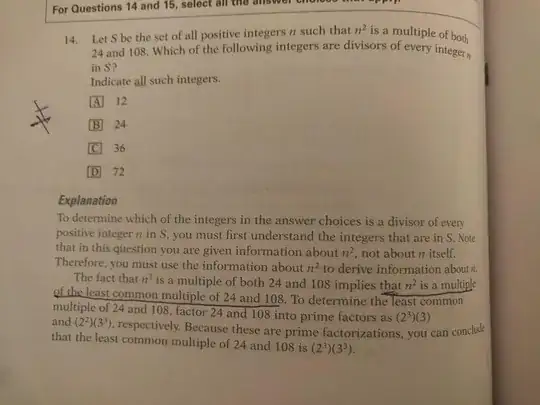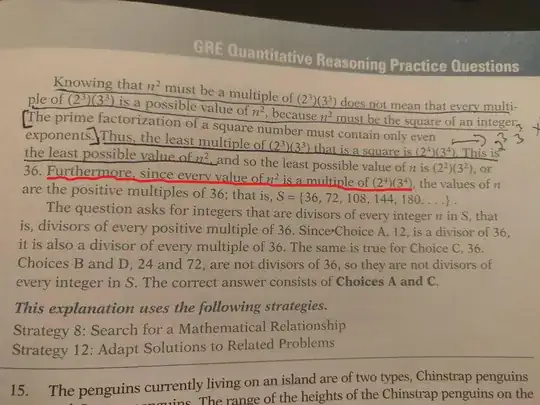[Moderators please note this is NOT a duplicate of
GRE problem involving LCD, prime factorization, and sets.
GRE test prep question [LCM and divisors]
These posts only answer how 36 is the lowest value memeber of S, but not HOW and WHY '36 is the lowest member of S' means 'all the integer multiples of 36 are also members of S'. ]
Here is a tricky math problem. I could understand half of its solution. But need help understanding the last bit.
Let S be the set of all positive integers n such that n^2 is a multiple >of both 24 and 108. Which of the following integers are divisors of >every integer n in S?
a)12 b)24 c)36 d)72
Solution: Since n^2 is said to be multiple of 24 and 108 it implies that n2 is also multiple of LCM of 24 and 108. The LCM of 24 and 108 is (2^3)(3^3). But this doesn't mean that every multiple of (2^3)(3^3) will be a member of {n^2}, and also since (2^3)(3^3) is not a perfect square its also not a member of {n^2}. The smallest member of {n^2} will be (2^3)(3^3)(6) i.e. (2^4)(3^4) and so the first member of set S is squrt((2^4)(3^4)) = (2^2)(3^2) = 36.
I have understood how to find the first member of set S and this in itself is enough to get the solution as (c) and (d).
The solution goes on the state that
Other members of {n^2} are all the positive integer multiples of (2^4) (3^4) and so the other members of set S are positive integer >multiples of 36.
I am not able to understand how it was concluded that the rest of the members of {n^2} are all the integer multiples of (2^4)(3^4) and no other (other than multiples of (2^4)(3^4)) numbers. Can anyone explain how just because (2^4)(3^4) is a member of {n^2} means all its multiples are also members of {n^2}?
Thank you.
NOTE: I get how 36 is the lowest member of S, as has be answered in other questions...what I am not able to understand is how does 36 being the lowest member of S means all its integer multiples are also part of S. Also, how is it that only the multiples of 36 are members of S?


$$\large\begin{align} n\in S!!! \overset{\rm def!!}\iff, & 2^3\cdot 3, 2^2\cdot 3^3\mid n^2\ \iff, & 2^3\cdot 3^3\mid n^2\ \iff, & 2^2\cdot 3^2\mid n \end{align}\qquad$$
For which step(s) above do you need further details?
– Bill Dubuque Mar 19 '21 at 16:13$$\large\begin{align} n\in S!!! \overset{\rm def!!}\iff, & 2^3\cdot 3, 2^2\cdot 3^3\mid n^2\ \iff, & 2^2\cdot 3,,\ 2\cdot 3^2\mid n\ \iff, & 2^2\cdot 3^2\mid n \end{align}\qquad$$
– Bill Dubuque Mar 19 '21 at 16:30